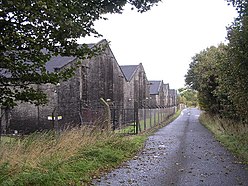Wilderness Plantation

| Wilderness Plantation | |
|---|---|
 Bonded warehouses near the site of the Roman Fortlet[1] | |
| Founded during the reign of | Antoninus Pius |
| Place in the Roman world | |
| Province | Britannia |
| Location | |
| County | East Dunbartonshire |
| Country | |
| Site notes | |
| Discovery year | 1965 |
| Condition | under crops |
| Excavation dates | 1965, 1966 |
Wilderness Plantation was the site of a Roman fortlet on the Antonine Wall in Scotland.[2]
The line of the Antonine Wall runs roughly parallel between the River Kelvin to the north and the Forth and Clyde Canal to the south.[3]
The site, like several others along the wall and beyond, was found by aerial photography, this discovery being reported in October 1965.[4] Following this Wilkes excavated in that year and the following one.[5] He approved of the term "interval fortlet" to describe this and other fortlets like Duntocher and Glasgow Bridge.[6]
The neighbouring forts to this fortlet are Balmuildy in the west and Cadder in the east.

No coinage has been recovered nor are there any inscriptions from the fortlet although a single coin was picked up at Wilderness West.[8]
Many Roman forts along the wall held garrisons of around 500 men.[9] Larger forts like Castlecary and Birrens had a nominal cohort of 1000 men[10] but probably sheltered women and children[11] as well although the troops were not allowed to marry.[12] There is likely too to have been large communities of civilians around the site.[13]

References
[edit]- ^ "near Wilderness Plantation". OpenStreetMap. Retrieved 18 November 2017.
- ^ "Wilderness Plantation". Canmore. Royal Commission on the Ancient and Historical Monuments of Scotland. Retrieved 14 November 2017.
- ^ "OS 25 inch map 1892-1949, with Bing opacity slider". National Library of Scotland. Ordnance Survey. Retrieved 12 October 2017.
- ^ "Wilderness Plantation". Canmore. Historic Environment Scotland. Retrieved 5 May 2018.
- ^ "WILDERNESS PLANTATION: FORTLET" (PDF). Frontiers of the Roman Empire. Retrieved 25 November 2017.
- ^ Wilkes, J. J. (September 2010). "The Antonine Wall Fortlet at Wilderness Plantation, Lanarkshire". Glasgow Archaeological Journal. 3 (3): 51–65. doi:10.3366/gas.1974.3.3.51. Retrieved 2 June 2018.
- ^ "Wilderness West, Antonine Wall". Canmore. Historic Environment Scotland. Retrieved 5 May 2018.
- ^ "Wilderness Plantation Antonine Wall Fortlet". Roman Britain. Retrieved 25 November 2017.
- ^ "Soldier". Frontiers of the Roman Empire. Retrieved 21 October 2017.
- ^ Miller, S. N. (1952). The Roman Occupation Of South Western Scotland Being Reports Of Excavations And Surveys Carried Out Under The Auspices Of The Glasgow Archaeological Society By John Clarke, J. M. Davidson, Anne S. Robertson, J. K. St. Joseph, Edited For The Society With An Historical Survey By S. N. Miller. Glasgow: Robert Maclehose & Company Limited. Retrieved 11 October 2017.
- ^ "Children". Frontiers of the Roman Empire. Retrieved 21 October 2017.
- ^ "Roman child's leather shoe". A History of the World. BBC. Retrieved 17 October 2017.
- ^ Rohl, Darrell, Jesse. "More than a Roman Monument: A Place-centred Approach to the Long-term History and Archaeology of the Antonine Wall" (PDF). Durham Theses. Durham University. Available at Durham E-Theses Online ref: 9458. Retrieved 14 October 2017.
{{cite web}}: CS1 maint: multiple names: authors list (link)